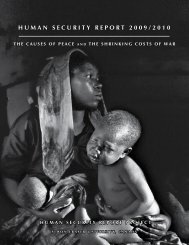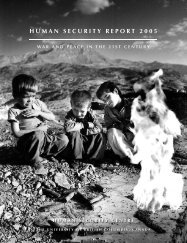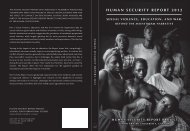Balkans. The Americas experienced a relatively stable low levelof one-sided deaths until 2001 and the September 11 attackon New York’s World Trade Center. Central and South Asiasuffered relatively few one-sided deaths, with the exceptionof a sharp peak in 1998 that was largely associated with theviolence in Afghanistan.The one-sided violence death toll in the Middle East andnorth Africa was also relatively low and stable until 2001.Between 2001 and 2004 the estimated number of civiliansintentionally killed increased twentyfold.Even if we exclude the slaughter in Rwanda, UCDP’s datasuggest that there has been a clear, albeit very uneven, globaldecline in the number of deaths resulting from one-sided violencesince 1994. From 1995 to 1999 UCDP recorded a (bestestimate) average of 8,000 civilian deaths per year; from 2000to 2005 the average had dropped to 4,800. But given uncertaintiesabout the death toll in Iraq and given the huge variationbetween the best and high estimates in Darfur, the datareally are not robust enough to make any claims about trendswith confidence.The Worst Perpetrators?Who perpetrates the most violence against civilians—governmentsor non-state armed groups? The answer depends onwhat is being measured.In the 17 years under review (1989 to 2005), non-statearmed groups instigated more violent campaigns against civiliansthan did governments—and they did so with increasingfrequency over the period. Far fewer governments have beenFigure 2.4 Number of Campaigns of One-sidedViolence by Perpetrator, 1989-200530Campaigns perpetrated by non-state armed groups25 Campaigns perpetrated by governments2015105019891990199119921993199419951996199719981999200020012002200320042005Data source: UCDP/Human Security Centre DatasetNon-state armed groups were responsible for mostcampaigns of organized violence against civiliansbetween 1989 and 2005.involved in organized violence against civilians than non-stategroups, but state-perpetrated violence killed more civilians infour out of the 17 years.As Figure 2.4 shows, the incidence of campaigns againstcivilians by non-state armed groups increased over the period,while the incidence of government campaigns changed little.Far fewer governments have been involvedin organized violence againstcivilians than non-state groups.The data, however, almost certainly underestimate theresponsibility of governments for killing civilians. In somecases—the Janjaweed militias in Darfur are an obvious contemporaryexample—non-state groups may be little morethan government surrogates.Genocides and PoliticidesBarbara Harff of the United States Naval Academy, whocompiled the genocide/politicide database used by thePolitical Instability Task Force (PITF), defines genocidesand politicides as campaigns of “political mass murder” thatare directed primarily against civilians and are intended toexterminate “in whole or in part” a communal, political,or politicized ethnic group. 27 (Politicides are similar togenocides except that their victims are targeted because oftheir political convictions rather than their ethnicity andreligion, as is the case with genocide.)While both PITF and UCDP’s one-sided violencedatasets record cases of organized violence against civilians,the PITF dataset is concerned primarily with campaigns ofmass violence.As Figure 2.5, which updates the 1956 to 2001 data presentedin the 2005 Human Security Report, shows, cases ofgenocide and politicide declined by 90% between 1989 and2005. Over the same period UCDP’s one-sided violence datasettracked a 55% increase in campaigns of violence againstcivilians—from 18 to 28.Given that both datasets are tracking organized violenceagainst civilians, how can such contradictory trendsbe explained?In fact there is no necessary contradiction. Professor Harff’sdataset only tracks a relatively small number of campaigns ofmass violence against civilians and almost all of these takeplace in the context of major intrastate armed conflicts. Since14H U M A N S E C U R I T Y B R I E F 2 0 0 6
12108642019561961Figure 2.5 Number of Genocidesand Politicides, 1956-2005196619711976the end of the Cold War the number of major intrastate conflictshas declined by some 80%; with this decline has come acommensurate reduction in genocides/politicides.UCDP, on the other hand, tracks the far more numerousminor campaigns of violence against civilians, in additionto genocides and politicides with their much higherdeath counts. The Harff dataset does not include any of theminor campaigns.Starting in 2001 the downward trendin international terrorism incidentswas reversed.1981Data source: Barbara Harff, 2005 28The number of genocides and politicides plummetedfollowing the end of the Cold War—a trend similarto that of high-intensity civil conflicts.1986199119962001a timely annual basis. MIPT has international terrorism datagoing back to 1968, and domestic terrorism data from 1998. 29MIPT counts many of the same events as UCDP’s onesidedviolence dataset and PITF’s genocide/politicide dataset.But unlike UCDP and PITF it does not count the killing ofcivilians by governments.As Figure 2.6 indicates, MIPT’s trend data reveal a fourfoldincrease in international terrorist incidents from 1968 to1991, followed by an almost fourfold decline by the end ofthe 1990s.Until the beginning of the new millennium, the internationalterrorism data followed a trend line remarkably similarto those of state-based armed conflicts and genocides/politicides—i.e.,a steady increase through the Cold War years followedby a sharp decrease in the 1990s. But over the past fiveyears there has been a dramatic change.Starting in 2001 the downward trend in international terroristincidents was reversed, and by 2004 there was almostfour times as many incidents as in 2001. The global incidenceof domestic terrorism also increased dramatically over the sameperiod. (MIPT only has data on domestic terrorism from 1998.)Figure 2.6 Number of InternationalTerrorist Incidents, 1968-200545040035030025020015010050So it is perfectly possible for mass campaigns against civiliansto decrease, while low-level campaigns increase. As notedearlier, however, there has as yet been no compelling explanationas to why the number of low-level campaigns should haverisen when other forms of political violence were falling.TerrorismTerrorism statistics provide a third measure of deadly threatsto the innocent, but here too obtaining access to reliable andtimely data is challenging.The Memorial Institute for the Prevention of Terrorism(MIPT), which codes and collates terrorism incident data providedby the RAND Corporation, is now the only institutionthat publishes updated international terrorism statistics on019681973197819831988199319982003Data source: MIPT Terrorism Knowledge Base 30The number of international terrorist attacks rosethrough the Cold War years, declined steeply inthe 1990s, but has risen steeply again in the newmillennium.But when the international terrorist incident data are disaggregatedon a regional basis it becomes clear that just tworegions are driving almost all of the post-2000 increase.Figure 2.7 shows the huge reported increase in internationalterrorism incidents in the Middle East and Persian Gulfand in South Asia. Most of the increased terrorist activity hasH U M A N S E C U R I T Y B R I E F 2 0 0 6 15






